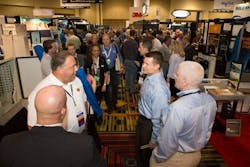More than 5,000 attendees gathered for the BICSI Winter Conference & Exhibition from February 22 to 26 at the Orlando World Center Marriott Convention Center to learn more about the products and services offered by the information and communications technology (ICT) industry.
With the advent of cloud computing, the growing options for setting up a network, and the need for high-performance computing, IT professionals are rethinking the design of their networks. And while moving to the cloud may solve a lot of problems for businesses, it adds a degree of complexity, such as the need for stringent security for the stored information. Consider also that the increase in data flow across already burdened networks comes from greater website activity, social media, smartphones, sensors, and numerous camera installations. For example, video camera security has evolved to a point where protecting people and assets is just one task among many, since the security system’s analytics add value beyond just capturing and storing an image.
Additionally, IEEE recently announced an 802.3 four-pair Power over Ethernet (PoE) Study Group to allow more than 25.5W of power on an Ethernet cable, which is the current limit of the IEEE 802.3at standard for serving cameras and other devices. The new standard, named 802.3bt, uses all four pairs of the cable construction to deliver up to 49W of power to PoE-enabled devices. When used in VoIP, wireless access points, and IP security appliances, a PoE system can save up to 50% of overall installation costs by not requiring separate electrical wiring and power outlets.
New developments are also taking place in the IEEE 802.3 working group to develop the next generation BASE-T Ethernet for Wireless Access Points (WAPs). Current generation (Wave I) devices are using 80MHz channels, but the next generation (Wave 2) 802.11ac devices will use 160 MHz channels (with performance enhancers) and approach data rates of 2Gigabit/s within 12 months and 4Gigabit/s in the next two years. Some industry professionals are looking forward to the use of multiple Gigabit Ethernet connections to each WAP. Others say that the best solution is to provide a 10 Gigabit Ethernet connection over Cat 6A cabling. Category 6A can also serve the next generation indoor cellar wireless systems, as well as Wi-Fi, following the TIA recommendations. With the dramatic increase in mobile traffic, future WAP offering may use dual or quad 1,000Base-T uplinks to support multi-gigabit backhaul requirements.
Manufacturers of testers for certifying or qualifying newly installed cabling systems are bringing in new technologies to achieve greater efficiency. After testing the cabling system at a job site, the technician links the results from the tester wirelessly to a smartphone, where the test results can be time stamped, GPS located and uploaded from the phone to a secure storage site in the cloud. At that point, the data is available to the project manager, or anyone on the construction project team, and the time spent in managing and accessing the test results is significantly reduced.
Preconference session highlights
In “Fundamentals of Passive Optical LAN,” Sean Kelly, TE Connectivity, Harrisburg, Pa., Matt Miller, Leidos, Columbia, Md., John Awad, WESCO/CSC, Buena Park, Calif., and Dustin Bateman, VT Group, Sterling, Va., explained the value proposition, architecture, and powering needs of a Passive Optical LAN (POL). POLs offer distinct advantages over standard Ethernet networks, since the electronics components have a service life of more than 25 years, as required by carriers, compared to five to eight years for enterprise-grade equipment. The two-day course also covered fiber installation, connector choice, inspection, cleaning, and testing.
In “Understanding Digital AV Technology and Systems,” Joseph Cornwall, Legrand, Cincinnati, Ohio, explained how the digital formats of video and audio material, including HDMI, Display Port, HDBaseT, UltraHD and wireless AV, is changing the delivery and storage of this material for maximum efficiency and copyright protection.
Conference session highlights
In “Defining the Next Generation of the IP Connected Enterprise: A Practitioner’s Guide to Best Practices,” Andrew Jimenez, Anixter, Glenview, Ill., offered an overview of how networks are being designed, built, and expanded to make the Internet of Things (IoT) possible. What once started as integrating PCs and storage onto a LAN, is now exploding into the integration of thousands of electronic-based items — located in homes, offices, factories, and highways, with the end result being value creation. The two technology forces making this possible are the use of the Ethernet protocol and convenience of having IP addresses for all endpoints (sensors and control devices) using the Internet protocol (IP).
The Internet of Things is defined as: “the interconnection of uniquely identifiable embedded computing devices within the existing Internet infrastructure.” For example, adding lighting and environmental sensors to office buildings allows a more precise control of the indoor climate, creating enhanced workspaces. The collected data also serves advanced HVAC control, and automated demand response can be integrated with existing building management systems.
In “Quality of Experience Over Wi-Fi – the Next Big Thing,” Jason Byrne, Greenlee Communications, Vista, Calif., described the use of recently developed test equipment for assessing Wi-Fi performance in a residence or premise before an installation is complete, thus reducing Wi-Fi-related callbacks. Designers and installers should understand that distance, obstructions, and installation methods affect the quality of the broadcast signal at any site. Approved in December 2013, the new 802.11ac WI-Fi standard, offering dual-band technology and impressive upload and download speeds, is finding its way into today’s homes, which have an average of seven Wi-Fi devices.
Byrne also noted a staggering growth projection in wireless communications: 9.5 billion mobile subscribers, an eight times growth in smartphone traffic, and a 10 times growth in mobile video traffic between 2014 and 2020. And by 2017, 60% of cellular traffic will be offloaded to Wi-Fi, since Wi-Fi is preferred by two-thirds of U.S. consumers, according to Deloitte.
In “New Class N – ITC Structured Cabling meets NFPA 72,” Vic Humm, Vic Humm & Associates, Chattanooga, Tenn., and Denise Pappas and Gordon Bailey, Valcom, Roanoke, Va., talked about the forthcoming NFPA 72, National Fire Alarm and Signaling Code, 2016 Edition, in which the use of Ethernet and other non-fire mass notification system (MNS) networks would be allowed to carry fire alarm information, if specific requirements are met. The requirements include:
1) the use of a primary and redundant pathways.
2) a loss of intended communications between end points is announced as a trouble signal.
3) a single open, ground, or short, or combination of faults on one pathway will not affect any other pathway.
The new Class N pathways are proposed to be subject to the same physical installation requirements as Class A and X circuits regarding separation of primary and redundant circuit paths. In all cases, the local Authority Having Jurisdiction (AHJ) would make the final judgment on implementation.
In “Healthcare ITC Trends and Innovations: Passive Optical LAN (GPON) for the New Era,” Michael Wilson, Tellabs, Naperville, lll, and Darren Vikan, RTKL, Baltimore, Md., explained how voice, data, video, and many other services, can be converged onto a redundant single-mode fiber network, able to support future bandwidth requirements. GPON refers to the use of the ITU G.984 standard, while EPON refers to the IEEE 802.3ah standard for PON. Both organizations are working to converge the two standards because this technology dramatically reduces the use of active Ethernet building aggregation/distribution switches and access layer switches. The main components of a PON are:
1) an optical network line terminal located in the equipment room or data center,
2) passive optical splitters located in specific areas, and
3) optical network terminals (ONT) located in end-user work areas or other spaces.
In addition to advanced encryption features, it also offers Layer 1 redundancy in various options while providing less than 5 sec. total system failover.






